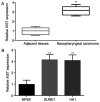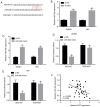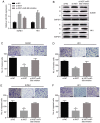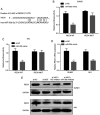lncRNA XIST regulates cell proliferation, migration and invasion via regulating miR-30b and RECK in nasopharyngeal carcinoma
- PMID: 33664820
- PMCID: PMC7882881
- DOI: 10.3892/ol.2021.12513
lncRNA XIST regulates cell proliferation, migration and invasion via regulating miR-30b and RECK in nasopharyngeal carcinoma
Abstract
Long non-coding RNA (lncRNA) X-inactive specific transcript (XIST) plays an essential role in the development and progress of nasopharyngeal carcinoma (NPC). MicroRNA-30b (miR-30b) has been confirmed to play an inhibitory role in various types of cancer. The molecular mechanisms underlying the lncRNA XIST-mediated regulation of the metastasis of NPC cells by miR-30b is not clear. qPCR and western blot analysis were used to detect the expression of XIST, miR-30b, and reversion inducing cysteine rich protein with kazal motifs (RECK) in NPC tissues and cell lines. The detection of luciferase reporter gene confirmed the relationship between lncRNA XIST, miR-30b and RECK. CCK-8 and Transwell assays were performed in order to detect the proliferation, migration and invasion of the NPC cells. The results of qPCR and western blotting indicated that the expression levels of lncRNA XIST and RECK were higher in the NPC tissues and cell lines than that of the control group, while the expression of miR-30b was lower. Knockdown of lncRNA XIST significantly inhibited cell proliferation, migration and invasion in the NPC cell lines. In addition, lncRNA XIST was found to negatively regulate the expression of miR-30b, resulting in the upregulation of RECK. Overexpression of RECK was found to reverse the inhibitory effect of lncRNA XIST knockdown or miR-30b on NPC cell metastasis. Our results showed that cell migration and invasion were inhibited by knockdown of lncRNA XIST, suggesting that the lncRNA XIST/miR-30b/RECK axis is involved in the development of NPC.
Keywords: RECK; long non-coding RNA XIST; miR-30b; nasopharyngeal carcinoma.
Copyright: © Sun et al.
Conflict of interest statement
The authors declare that they have no competing interests.
Figures






Similar articles
-
LncRNA XIST knockdown suppresses the malignancy of human nasopharyngeal carcinoma through XIST/miRNA-148a-3p/ADAM17 pathway in vitro and in vivo.Biomed Pharmacother. 2020 Jan;121:109620. doi: 10.1016/j.biopha.2019.109620. Epub 2019 Nov 20. Biomed Pharmacother. 2020. PMID: 31810117
-
Knockdown of lncRNA XIST inhibits hypoxia-induced glycolysis, migration and invasion through regulating miR-381-3p/NEK5 axis in nasopharyngeal carcinoma.Eur Rev Med Pharmacol Sci. 2020 Mar;24(5):2505-2517. doi: 10.26355/eurrev_202003_20518. Eur Rev Med Pharmacol Sci. 2020. PMID: 32196601
-
Down-regulated microRNA-30b-3p inhibits proliferation, invasion and migration of glioma cells via inactivation of the AKT signaling pathway by up-regulating RECK.Biosci Rep. 2019 Aug 13;39(8):BSR20182226. doi: 10.1042/BSR20182226. Print 2019 Aug 30. Biosci Rep. 2019. Retraction in: Biosci Rep. 2024 May 29;44(5):BSR-2018-2226_RET. doi: 10.1042/BSR-2018-2226_RET. PMID: 31270250 Free PMC article. Retracted.
-
The role of lncRNAs and XIST in oral cancer.Front Cell Dev Biol. 2022 Aug 10;10:826650. doi: 10.3389/fcell.2022.826650. eCollection 2022. Front Cell Dev Biol. 2022. PMID: 36035993 Free PMC article. Review.
-
Regulation of miR-30b in cancer development, apoptosis, and drug resistance.Open Life Sci. 2022 Feb 28;17(1):102-106. doi: 10.1515/biol-2022-0017. eCollection 2022. Open Life Sci. 2022. PMID: 35291564 Free PMC article. Review.
Cited by
-
Current understanding of functional peptides encoded by lncRNA in cancer.Cancer Cell Int. 2024 Jul 19;24(1):252. doi: 10.1186/s12935-024-03446-7. Cancer Cell Int. 2024. PMID: 39030557 Free PMC article. Review.
-
Potential roles of lncRNA-XIST/miRNAs/mRNAs in human cancer cells.Clin Transl Oncol. 2023 Jul;25(7):2015-2042. doi: 10.1007/s12094-023-03110-y. Epub 2023 Feb 28. Clin Transl Oncol. 2023. PMID: 36853400 Review.
-
The lncRNAs at X Chromosome Inactivation Center: Not Just a Matter of Sex Dosage Compensation.Int J Mol Sci. 2022 Jan 6;23(2):611. doi: 10.3390/ijms23020611. Int J Mol Sci. 2022. PMID: 35054794 Free PMC article. Review.
-
RECK as a Potential Crucial Molecule for the Targeted Treatment of Sepsis.J Inflamm Res. 2025 Feb 6;18:1787-1813. doi: 10.2147/JIR.S501856. eCollection 2025. J Inflamm Res. 2025. PMID: 39931174 Free PMC article. Review.
References
-
- Prensner JR, Chinnaiyan AM. The emergence of lncRNAs in cancer biology. Cancer Discov. 2011;1:391–407. doi: 10.1158/2159-8290.CD-11-0209. - DOI - PMC - PubMed
LinkOut - more resources
Full Text Sources
Other Literature Sources
